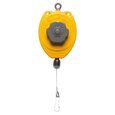Selecting the Right Tool Balancer
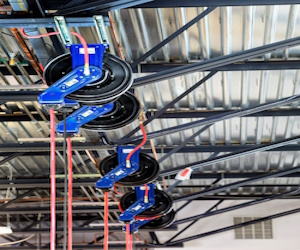
Figure 1: Hose reel tool balancer
Tool balancers are designed to balance a hand-operated tool in a pre-set position and support its load rather than having the operator support it. The hand-operated tools, used by operators on a frequent basis can cause fatigue and impact their health over time. Tool balancers act as an easy fix by carrying the load of the tool, thus increasing productivity, safety, and efficiency. They are also called load balancers and spring balancers.
View our online selection of tool balancers!
Types of tool balancers
Tool balancers work by providing ergonomic support for operators performing heavy and repetitive tasks in the manufacturing environment. However, different types of industrial tool balancers provide different functionalities. Depending upon the different operating mechanisms, tool balancers can be classified as either a:
- Retractor tool balancer
- Hose reel tool balancer
- Zero gravity tool balancer
Retractor tool balancer
Retractor tool balancers are the most commonly used tool balancers in the production setting. They are set up slightly above the tools to be used and the tools are simply connected to the end of the reel. For a spring tool balancer, the user pulls down the cable of the balancer to hold the tool. The operator simply lets go once done and the tool balancer retracts the tool back up. The internal spring mechanism exerts constant pressure on the cable to retract, so once the operator releases it, the cable retracts back to its original position. A spring balancer is a tool holder that is typically mounted above the workbench so it pulls the tool upwards. However, the spring mechanism can create some upward pressure leading to some strains for operators while handling the tool. A small tool balancer can be used to balance small hand tools such as drills, wrenches, and screwdrivers. Figure 2 shows a spring tool retractor. Tameson has a large library of technical articles, which also covers tools such as tube cutters and strap wrenches, and we explain how to use thread cutting equipment.
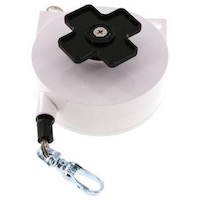
Figure 2: Retractor tool balancer
Hose reel tool balancer
Hose reel tool balancers also utilize an internal spring mechanism to operate. However, unlike retractor tool balancers, the hose reel tool balancer utilizes a pneumatic hose as a support cable and is designed to work mostly with small pneumatic tools. Therefore, the tool has pneumatic air through the hose and don’t have to balance the tool’s load. The addition of the hose allows operators to keep their workstations clean reducing accidental trips, falls, and damages.
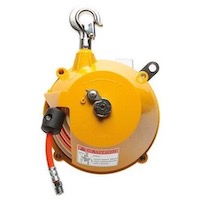
Figure 3: Hose reel tool balancer
Zero gravity tool balancer
Zero gravity tool balancers are popular for their ability to handle a higher load than the spring balancer type. So, this is a great choice for heavy-duty tool applications. As the zero-gravity tool balancer does not rely on the internal spring mechanism, no upward pressure is exerted on the operator. Once released, the tool remains in the same position in the air. While this heavy duty tool balancer can be comparatively expensive, it facilitates improved safety and productivity for the operation.
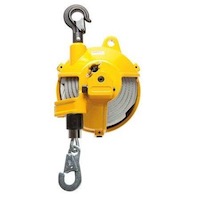
Figure 4: Zero gravity tool balancer
Selecting the right tool balancer
Depending upon the facility, size, weight of the tool, and cost parameters, the choice of tool balancers can differ. The following table presents the comparison between the different types of tool balancers.
| Retractor tool balancer | Hose reel tool balancer | Zero gravity tool balancer |
|---|---|---|
| Suitable to hold up to 10 pounds. | Suitable to hold up to 10 pounds. | Suitable to hold up to 264 pounds. |
| Less costly than zero gravity tool balancer. | Less costly than zero gravity tool balancer. | More expensive than other tool balancers. |
| Utilizes spring mechanism that exerts upward pressure which can lead to some strains for operators. | Utilizes spring mechanism which can cause some strains for operators due to upward pressure. | Does not rely on an internal spring mechanism, so operators are not prone to strain due to upward pressure on the tool. |
| Utilizes a basic cable to hold small tools. | Utilizes a pneumatic hose as a support cable to work with small pneumatic tools. | Utilizes a cable to hold heavy-duty tools. |




